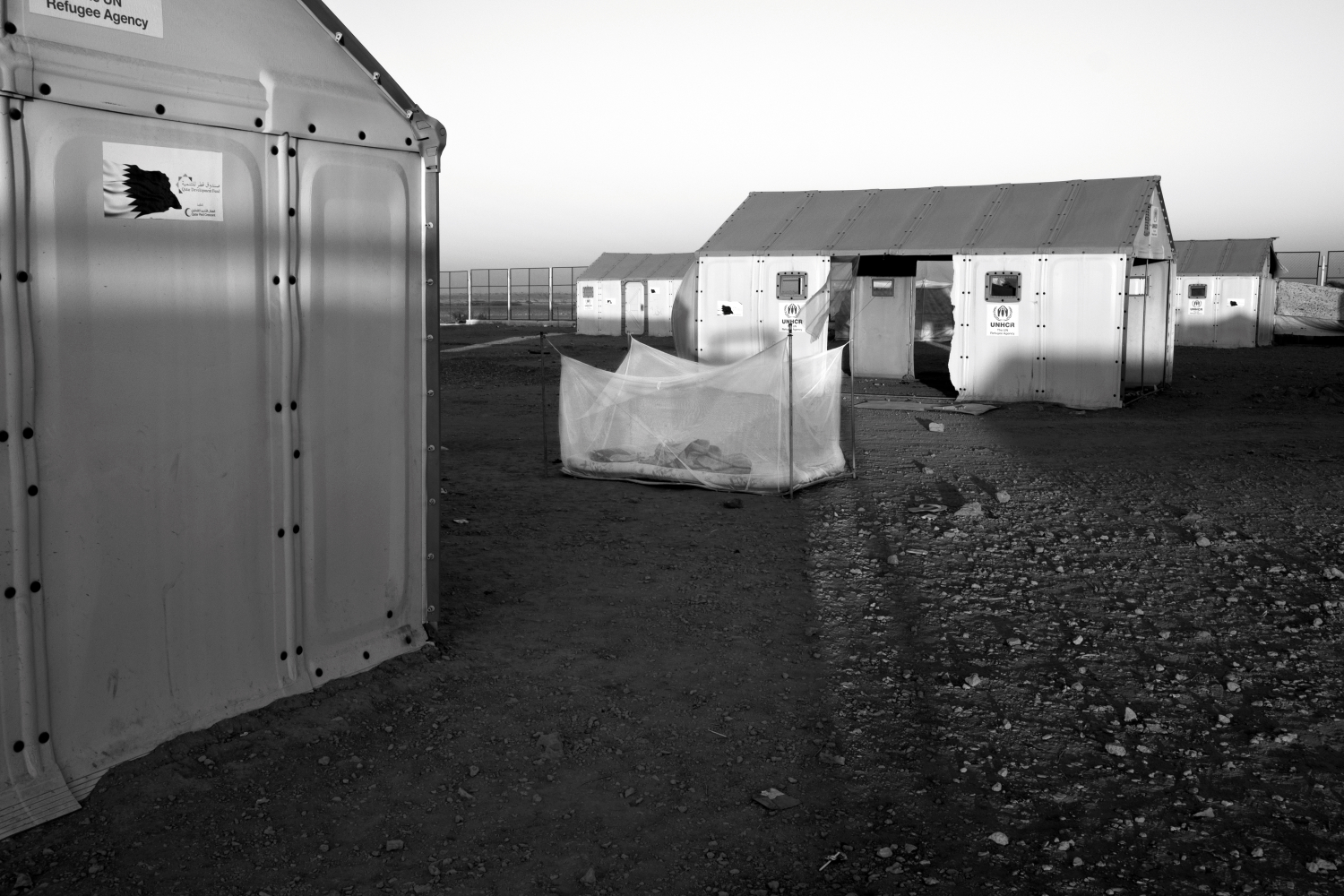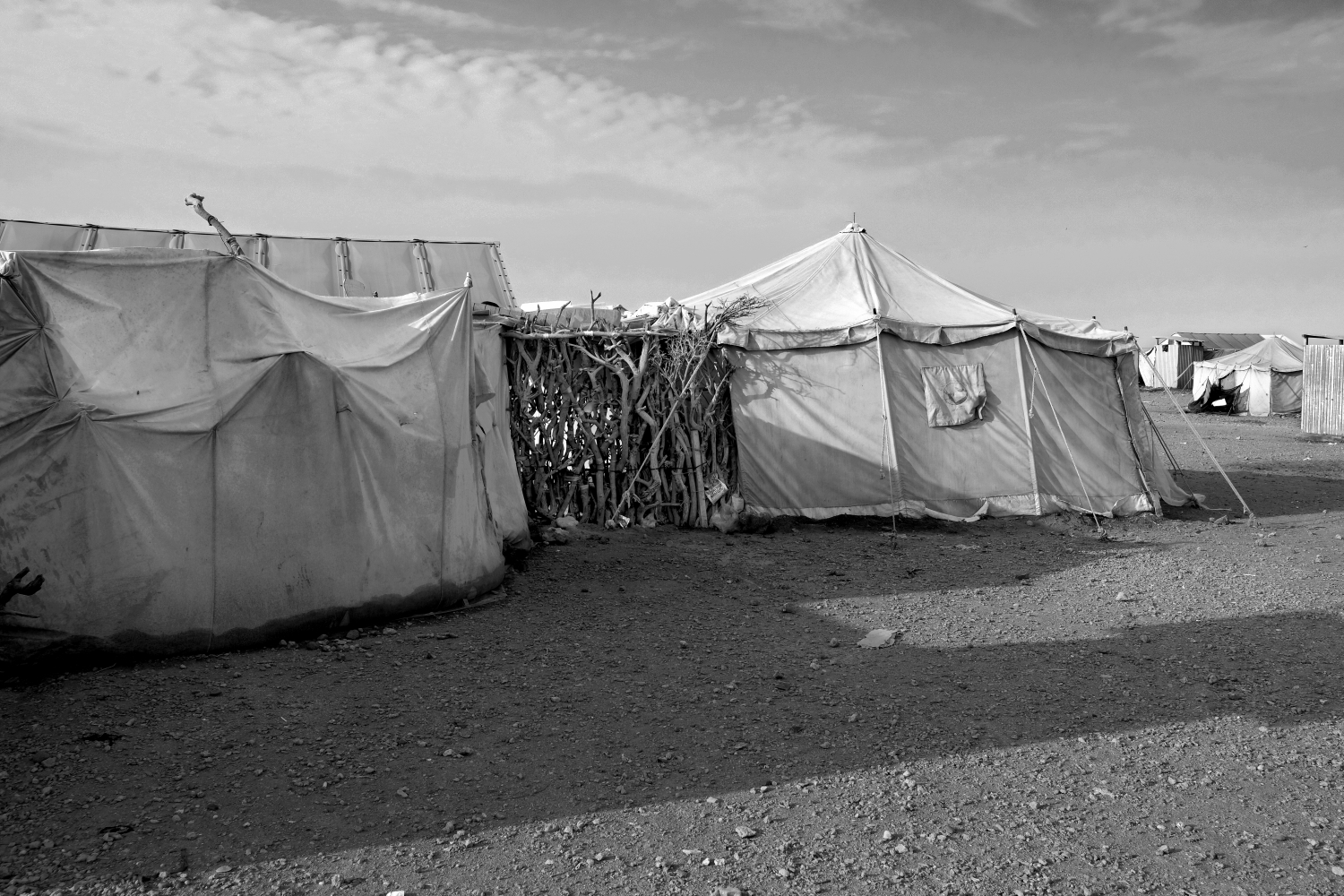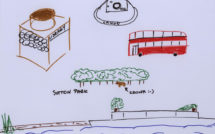
This is part of our special feature on Forced Migration, Displacement, and the Liberal Arts.
The works of French-Algerian photographer Nadia Benchallal focus on the stasis experienced by the refugees displaced by the conflict in Yemen—forced to flee, yet unable to move on from the camps they find themselves in. Within this (im)mobility, Benchallal explores the spark of human dignity still to be found amidst a dehumanizing conflict orchestrated by transnational forces. Collaborative and grounded in mundanity, these pictures represent the complex lives of those navigating a visceral and very human reality.
—Nicole Shea for EuropeNow






Markazi is a photography project that casts light on the conditions of mobility and immobility in Yemen and the Horn of Africa. Taken over the course of several extended visits in 2016–2018 to the Markazi refugee camp in northeast Djibouti, Benchallal’s photographs depict the camp’s predominantly Yemeni residents navigating a state of increasingly permanent suspension.
This month marks the four-year anniversary of the Saudi Arabian-led military intervention in Yemen. Since March 2015, millions of Yemenis have been suffering from malnutrition, hunger, disease epidemics, and critical shortages of medicines, fuel, and clean water—a crisis that is widely considered the “worst manmade humanitarian crisis in the world.”[1] As many as three million Yemenis have been internally displaced.[2] And approximately 190,000 people have sought refuge in neighboring countries, including Djibouti.[3]
Located at its narrowest crossing just thirty kilometers across the Red Sea from Yemen, Djibouti has received nearly 40,000 of these individuals since 2015, the majority of whom have migrated onward.[4] Despite its being one of the poorest and smallest countries in Africa, Djibouti maintains an open-door policy for refugees. It currently hosts more than 29,000 refugees and asylum seekers from Somalia, Ethiopia, Eritrea, and Yemen.[5] Markazi—meaning “central” in Arabic—is the world’s only camp for refugees from Yemen. Now home to around 2,000 individuals, Markazi is a site of convergence for persons displaced from Yemen’s coastal fishing villages and urban centers. It is also at a crossroads, located within kilometers of the Red Sea harbors from where thousands of young Ethiopian migrants disembark on their own perilous sea crossings to Yemen with the intent of reaching Saudi Arabia and finding work. In 2018, approximately 160,000 East African migrants crossed the Red Sea and entered war-torn Yemen,[6] exceeding the number of migrants (144,000) who entered Europe via the Mediterranean Sea the same year.[7] A cheaper but no less dangerous route, this Red Sea crossing took the lives of at least 52 migrants this January when two overcrowded boats capsized off the coast of northeast Djibouti.[8]
The Yemeni refugees living in Markazi are witness to the tens of Ethiopian migrants—including unaccompanied minors—walking past their camp each day. Against this backdrop of constant, daily migration, their own lives feel stagnant and suspended: an interminable wait for the world to take notice. Many of the camp’s residents fled Yemen when bombs and missiles struck their coastal villages. Others boarded boats to Djibouti, the only exit route available to them, with the hope of reaching Europe or North America. Four years later, it is evident that neither their repatriation nor resettlement is likely; the conflict remains intractable and few third countries are accepting refugees from Yemen.
Benchallal’s photographs depict these refugees’ daily efforts and exertions to survive their encampment on this windswept, desert plain. This particular set of photographs portrays the camp’s evolving architecture of containment. Initially, the refugees were housed in canvas tents issued by the United Nations High Commission for Refugees (UNCHR), few of which survived the first summer’s raging khamsin winds. In October 2015, the Qatari Red Crescent donated 300 “Better Shelter” refugee housing units designed by the IKEA Foundation. These polypropylene “caravans,” as the Yemenis call them, become oppressively hot in Djibouti’s tropical desert climate. Many of the camp’s residents use their caravan instead as a kitchen, storage unit, or a shed within a larger residential compound constructed from tents, gathered wood, plywood, mosquito netting, and fishing nets. The nets ward off insects, enabling individuals to sleep outside their caravan, but also serve as a barrier against the area’s wild baboons, unbridled camels, and stray dogs. Caravans abandoned by the families who have returned to Yemen—not because their homeland is safe, but because they tired of languishing in Djibouti without paid work or university-level education—are repurposed as benches, doors, and walls.
In 2017, two Turkish companies funded by Saudi Arabia’s King Salman Humanitarian Aid and Relief Center began constructing 300 24-sq. meter composite container homes, an elementary school, and a new mosque inside the boundaries of Markazi. Opened in November 2018, this “Saudi village” as it is now officially called houses Yemeni refugees whose homes were destroyed by the Saudi-led coalition’s—and US and EU-supported—air strikes. Some refugees have refused to leave their makeshift structures for these more durable (and air-conditioned) containers, fearing that if they move physically from their UNCHR tent to the Saudi village, they will be moving jurisdictionally from the shelter of international protection to the prison of permanent displacement. As one Yemeni refugee wrote, “We don’t need food, we need to get the fuck out here. No future.” This young man has since given up on finding a future outside of Yemen and returned, again, by sea; his makeshift shelter has been torn down and recycled. Benchallal’s photographs capture a time when Yemeni refugees harbored greater hope of a future outside of the camp, and beyond.
—Nathalie Peutz for EuropeNow
Nadia Benchallal is an award-winning French-Algerian photographer who lives in France. She studied photography at the International Center of Photography (ICP) in New York City. She has worked for international magazines and newspapers including Le Monde, Geo, El País, Time Magazine, Die Zeit, New York Times, La Republica Della Donna, and Newsweek. She has traveled extensively for her work to places such as Saudi Arabia, Palestine, Bangladesh, Japan, Malaysia, and Turkey and her work has been widely exhibited in museums, galleries, and photo festivals. She has received awards from Visa d’Or, Photojournalism Festival, Perpignan in France, (First Award), Paul Vaillant Couturier in France (First Award), the World Press Photo Foundation People in News (Third Prize), and from Face to Face in Spain for her project, “Sisters, Muslim women around the world.” Her work has been supported by a W. Eugene Smith Fellowship, the Mother Jones grant, UNESCO, the FIACRE from the Ministry of Culture in France, and Akkasah, Center for Photography at New York University Abu Dhabi.
Nathalie Peutz is an Assistant Professor of Anthropology in the Program of Arab Crossroads Studies at New York University Abu Dhabi. She is the author of Islands of Heritage: Conservation and Transformation in Yemen (Stanford University Press, 2018) and the co-editor (with Nicholas De Genova) of The Deportation Regime: Sovereignty, Space, and the Freedom of Movement (Duke University Press, 2010). Peutz is currently conducting research on Yemeni refugees in the Horn of Africa.
References:
[1] https://www.unocha.org/2018-yemen-high-level-pledging-event
[2] http://www.internal-displacement.org/countries/yemen
[3] https://www.unhcr.org/yemen-emergency.html
[4] https://data2.unhcr.org/en/situations/yemen
[5] http://reporting.unhcr.org/sites/default/files/UNHCR%20Djibouti%20Fact%20Sheet%20-%20January%202019.pdf
[6] https://reliefweb.int/report/yemen/flow-monitoring-points-2018-migrant-arrivals-and-yemeni-returns-saudi-arabia-january
[7] http://migration.iom.int/europe?type=arrivals
[8] https://www.nytimes.com/2019/01/30/world/africa/migrants-dead-djibouti.html
Published on March 5, 2019.




